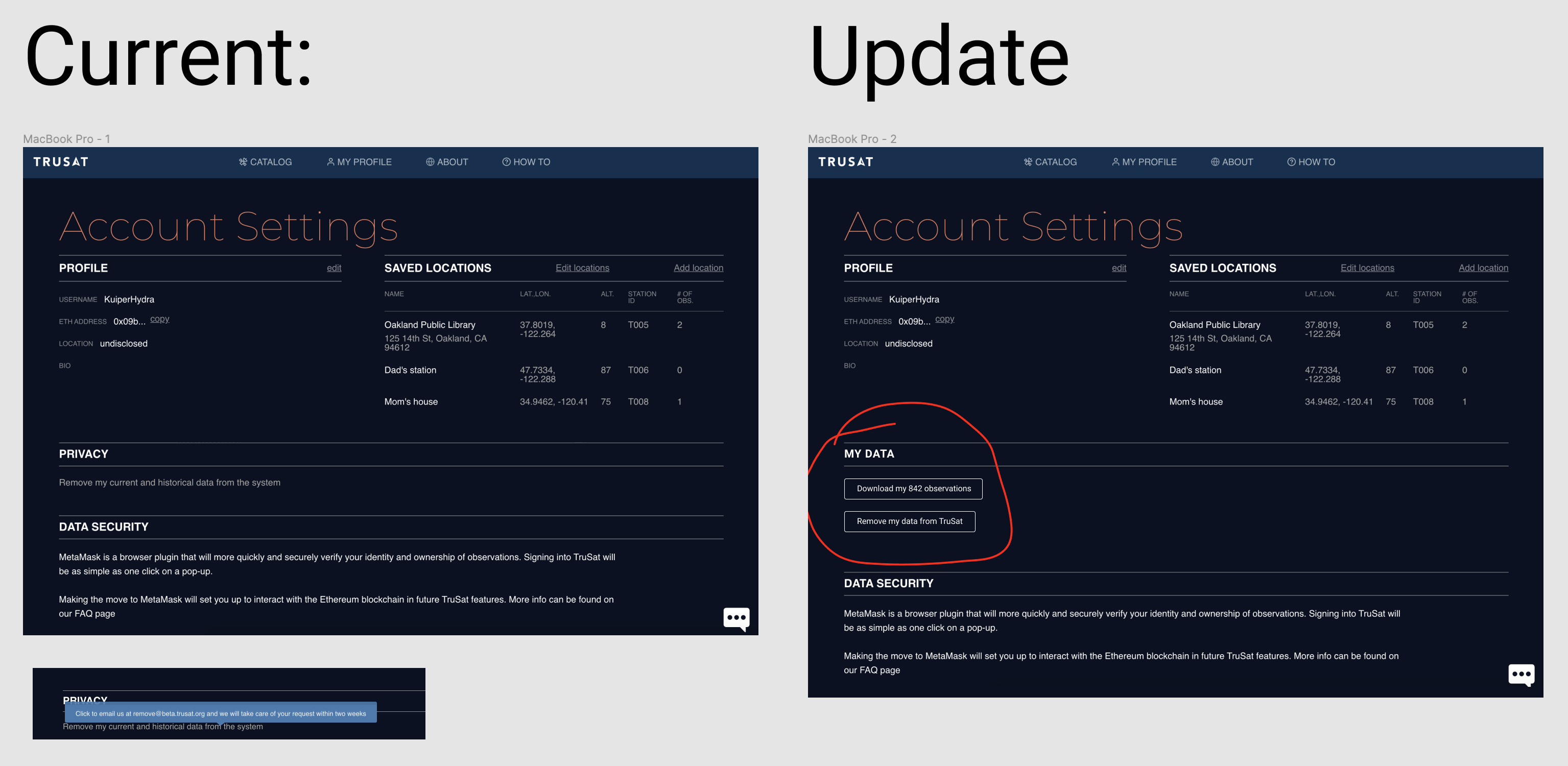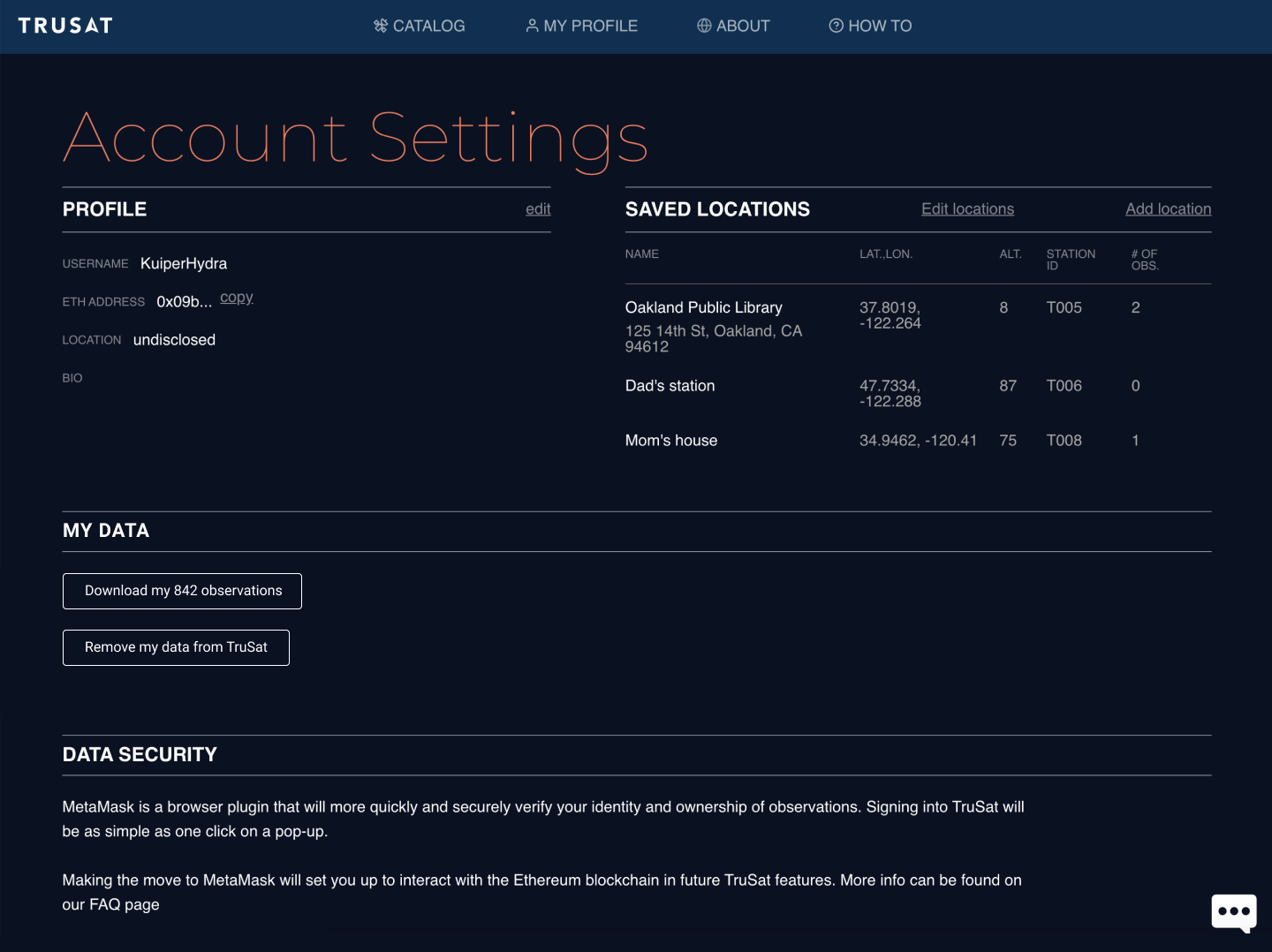trusat-frontend
 trusat-frontend copied to clipboard
trusat-frontend copied to clipboard
Access to raw observations
The raw observations, as they were submitted, should be downloadable, preferably through an API. The API could provide a filter for satellite ID, observer, observation format and a time range.
@cbassa How about we start with the ability for someone to download their own observations first? It will take more time to implement a feature that enables some users to share observations publicly, and other users to keep their data private—but a private button to "download my observations" should be easier to implement in the near-term.
@johngribbin A button to download observations can go on a user's account settings page, and link to a text file.
Before and after:

Mockup detail:

Nice to haves: Button displays number of observations available to download.
I'm also suggesting a slight update to the labeling to clarify the functions for this section:
- Change “privacy” section header to “my data”
- Change style of “Remove my currrent and historical data...” link to match the new button, labeled “Remove my data from TruSat”
- change tooltip text from “Click to email us at [email protected] and we will take care of your request within two weeks” to “Click to email us at [email protected] and we will remove your current and historical data from the system
Implementing a feature to download your own data is indeed a good place to start.
My main interest in this feature would still be to access all available data on a given satellite, to allow analysis by third parties.
@cbassa I'd love to create a web-query interface, or allow direct read-query access to the SQL database for Obs, TLEs, and the derived data in-between... the limiting consideration has been maintaining the privacy of those observers who do either not want to:
- Share their observation location publicly, or
- Share their observation activity non-anonymously
(1) is a bigger restriction to full access of observations -- and Mike from SeeSat clearly gets a large amount of observations which are submitted directly to him, and obfuscated by only sharing the TLEs.
Do you have any suggestions on how to mitigate the privacy concern that would allow a step forward here?
For functionality and setting up views, queries and interfaces - setting up a TLE query interface would probably be a development starting point that would make implementing the above a quick step, once we address the privacy issues appropriately. Being able to query TruSat TLEs (as well as McCants TLEs, which can be easily made available via the same interface) would be a nice benefit not currently available in the non-NORAD environment.
Any measurement of a satellite position or velocity made by an observer will require the observer location, as without it the measurement is useless, so if the data is truly shared in an open framework then the data must include the observer location. Maybe I am misinterpreting how TruSat intends to use blockchain, but I understood that the measurements would be part of the blockchain, and hence be open. Is that not the case?
Of course - the location of the observation is essential. However, the privacy concern hasn't been solved yet, so we're still keeping the the Station Location data only accessible to the user (and the developers) until we solve it. And once its solved, then we can register the data on-chain...
Ideally, we'd like an "open" system with user-granted-permissioned access to sensitive data -- revokable if possible.
@cbassa You can now download your observations by clicking "Download my [count] Observations" when logged in via https://trusat.org/settings
You don't currently have any observations in the database. Would you like to create an account to test?
I mentioned this in an email but could add some thoughts here. My interest in editing observations (download, edit, resubmit??) is due to my working through options when generating observations since I am just learning. For those of us (just me?) that take photos with a DSLR, we need to know the exact time of shutter opening. After looking at this in exhausting detail (and it has been exhausting) there are two options for setting time in the DSLR - synch with the computer or manually via the time on a web page, an app on my iPhone, etc. I started by synching with the computer - now I see that it tends to be 3 to 3.5 sec slow. Grr. I would like to go back and edit observations and add that three seconds - then see what the residuals are. Also, the RA and Dec from Astrometry.net, World Wide Telescope, are different that those from SAO Image DS 9. Grr. Which is "correct"? I would like to edit observations so I can essentially submit an observation with each set of angles - and see which site gives me smaller residuals. These are two reasons that it would be great to be able to edit observations - and see residuals for each version.